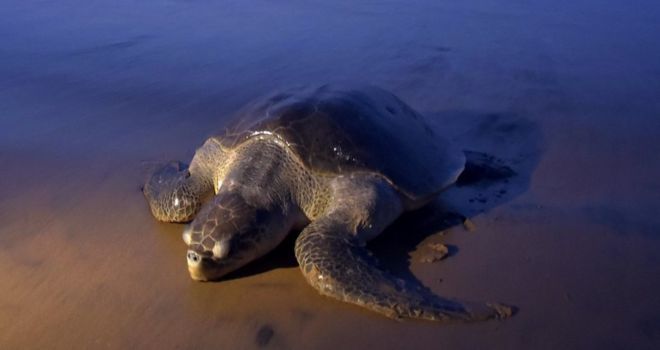 ASIT KUMAR/AFP/GETTY IMAGES
ASIT KUMAR/AFP/GETTY IMAGES
On the eastern coast of India, in the state of Orissa, lie three big nesting sites for one of the world's smallest sea turtles - the Olive Ridley.
Every winter, thousands of females return to these shores to nest.
Journalists Supriya Vohra and Meesha Holley witnessed the synchronised move, which is known as "arribada"- the Spanish for arrival.
This photo essay spotlights the turtles breeding on the beaches near Rushikulya, and the nearby fishing villages.
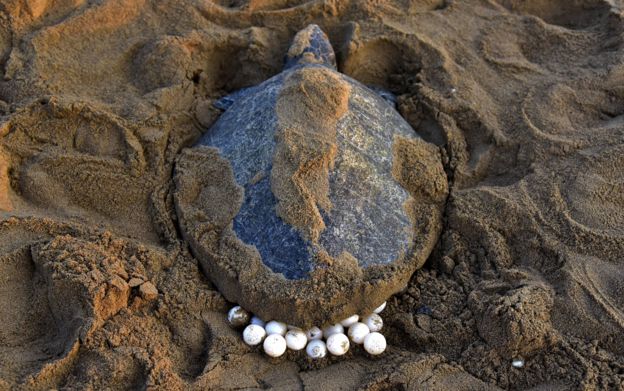 ASIT KUMAR/AFP/GETTY IMAGES
ASIT KUMAR/AFP/GETTY IMAGES
After about seven weeks of incubation, the Olive Ridley hatchling scrapes open its egg and scrambles out into the sandy world beyond.
Using the nutrients in the shell, it powers its way towards the open water.
The walk to the ocean is a crucial journey for the tiny turtle, strengthening its flippers and preparing it for the long journey ahead.
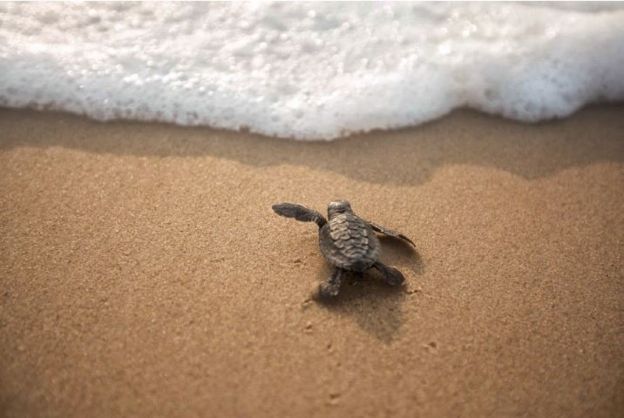 MEESHA HOLLEY
MEESHA HOLLEY
The Olive Ridley is one of the five species of sea turtle that mate and nest on India's shores. They are protected under the country's Wildlife Protection Act 1972.
The entire stretch of the nesting beach is a 4.1km (2.5 mile) shoreline, covering three small fishing villages - Podampetta, Gokharkuda and Purunabandha, in Orissa's Ganjam district.
The beach lies near the mouth of the Rushikulya River, where it meets the Bay of Bengal.
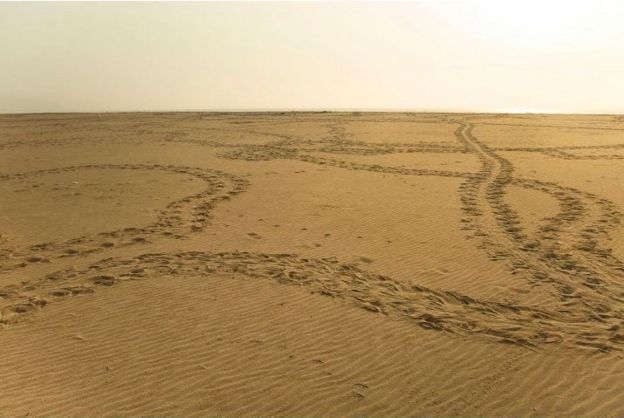 MEESHA HOLLEY
MEESHA HOLLEY
Every year, the Olive Ridleys return to their birthplace for the four-month nesting season.
Scientists discovered that turtles are guided by the earth's magnetic field, and follow the ocean's currents instead of swimming against the tide.
This magnetic field directs them back to the first sand they ever saw.
 MEESHA HOLLEY
MEESHA HOLLEY
The mass nesting site or rookery of Rushikulya was first discovered in the early 1990s.
Since the area is so close to fishing villages, much research has gone into understanding how human and turtle communities can share the space.
Conservation efforts have been launched by the state's forest department, the fisheries department, local non-profits and the district administration.
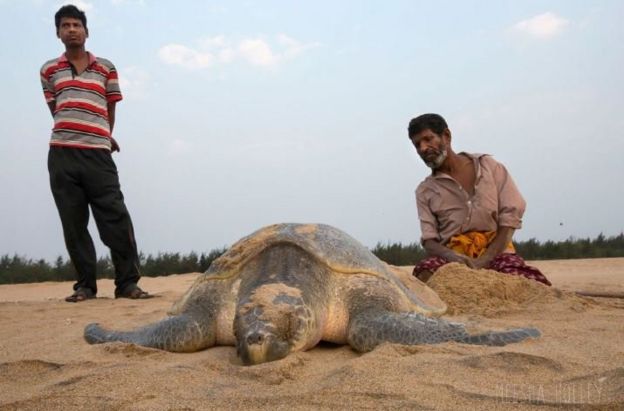 MEESHA HOLLEY
MEESHA HOLLEY
Rabindra Nath Sahu, 36, has played a key role in the turtle conservation movement. A local of Purunabandha, he learned about the arribada as a 14-year-old.
"We never harmed the turtles, as they were considered an avatar of Lord Vishnu [a Hindu deity], but we used to take the eggs and eat them or sell them.
"But in 1993, Bivash Panday, a scientist with Wildlife Institute of India, visited this region and showed us this incredible phenomenon of arribada. I think we tagged about 10,000 nesting turtles then.
"I have been hooked on turtle conservation work ever since, and can assure you that NOBODY in any of these three villages now even dreams of poaching the precious creatures. And it is going to stay this way."
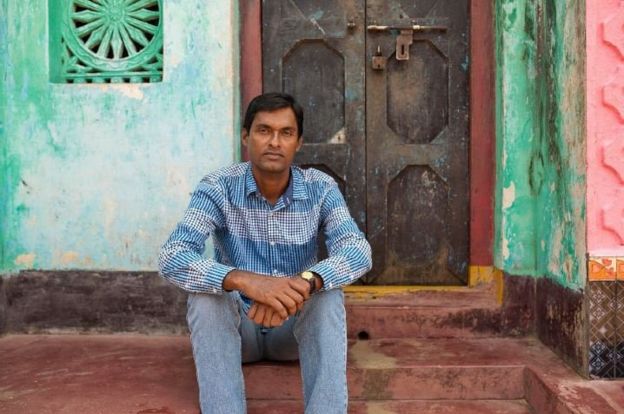 MEESHA HOLLEY
MEESHA HOLLEY
Turtle eggs and hatchlings are believed to have a survival ratio of one in 1,000.
In Rushikulya, they fall victim to prowling stray dogs and predatory birds. Some hatchlings get caught in fishing nets, while others are disorientated by artificial light from nearby towns and factories.
To boost the babies' chances, the forest department and conservation groups like the World Wildlife Fund have their own hatcheries, and employ guards to patrol the nesting sites.
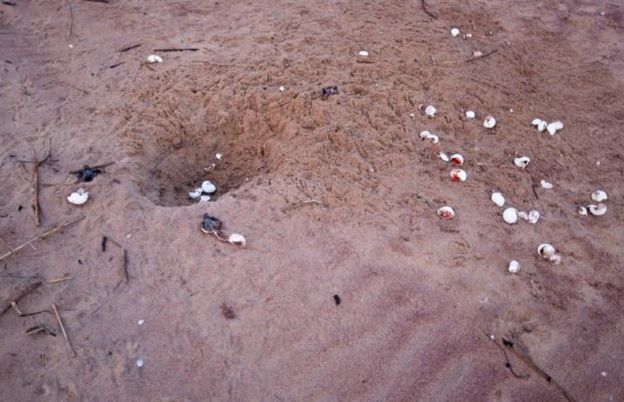 MEESHA HOLLEY
MEESHA HOLLEY
After leaving its shell, the newborn turtle has to make the long, perilous journey towards the ocean.
During this time, the local communities get together and patrol the beach, collecting the hatchlings in buckets and releasing them near the sea.
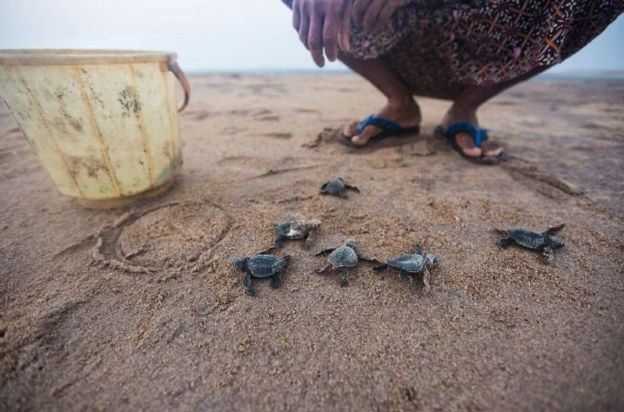 MEESHA HOLLEY
MEESHA HOLLEY
During the arribada and hatching period, fishing is restricted to prevent any damage to the animal.
Mechanised trawling is banned within 10km, and the fisheries department offers affected families subsidised rice rations for up to six months as a form of compensation.
However, the sheer number of turtles in the water can still destroy fishing nets, leading to lost income.
 MEESHA HOLLEY
MEESHA HOLLEY
Magata Behera is from Purunabandha, and works in conservation with Rabindra Nath Sahu.
"We are truly a converted lot," he says. "Everyone shares a certain love for these turtles. World Turtle Day [on 23 May] means a lot to us, and we celebrate it in a big way.
"We really want our communities to prosper. If our district is known worldwide for arribada, then we want our people to benefit from it in some way.
"We want to create alternative livelihoods for them."
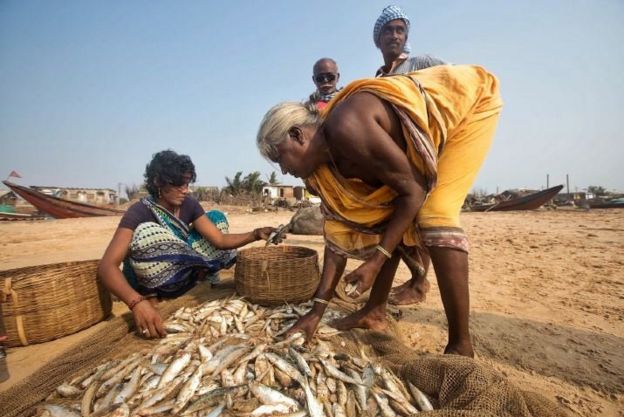 MEESHA HOLLEY
MEESHA HOLLEY
These ancient ocean wanderers have been making their enormous migrations the same way for millions of years.
The smaller communities who live alongside them are playing their part for conservation.
But it's ultimately down to the big players - the Orissa state government and local industries - to ensure that development and turtle protection go hand-in-hand.
 MEESHA HOLLEY
MEESHA HOLLEY
No comments:
Post a Comment